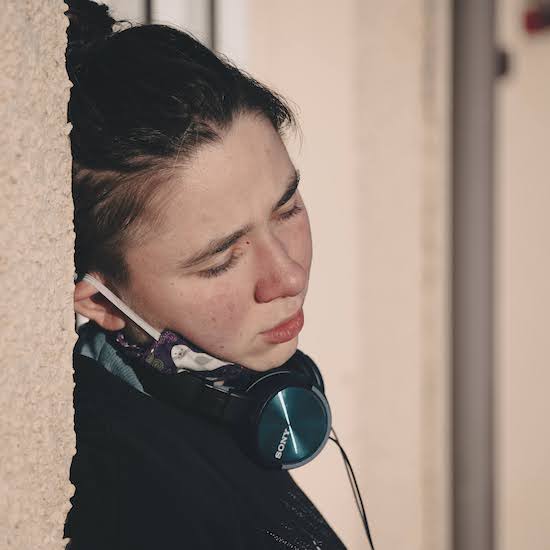Rufus Isabel Elliot by Jordan of LiveLoveRun
Three Sexual Pieces for Violin shapeshifts from gritty, forlorn textures into bittersweet reminiscences, foregrounding the ever-changing voice of a solo violin. Composer Rufus Isabel Elliot writes fleeting feelings that violinist Harry Gorski-Brown illuminates in textured blips of sound. The album, which features three pieces written between 2018 and 2020, tells stories about sexual intimacy using text scores that capture the essence of each piece through short phrases to create moods through abstract ideas rather than conventional melodies and rhythms.
Elliot, who’s from East London and currently lives in Scotland, hadn’t always set out to be a composer. As an undergraduate, it primarily studied English. It had always thought composition had to be something structured like Bach or Beethoven, which it didn’t want to do. But one of Elliot’s teachers didn’t see composition that way – the teacher thought writing music could mean anything and didn’t have to just be counterpoint. That’s when things changed.
The pieces Elliot started to write veered away from the classical tradition. Today, its works often employ text scores that instruct the performers rather than standard score notation. These text scores provide colourful snippets of language that Elliot, the artist and the audience may each interpret in a different way. It’s poetry that then becomes translated into sound and that sound may be different to everyone’s ears – which is the crux of Elliot’s musical practice. Much of its writing focuses on lived experiences, but the works leave room for an individual’s interpretation, ultimately leaving us with a more intimate understanding of ourselves and each other.
Eventually, Elliot moved to Scotland to study composition at the Royal Conservatoire of Scotland. In Scotland, it noticed trans and nonbinary artists didn’t have a lot of community spaces, so it started the Over/At series for trans and nonbinary composers during the first wave of the COVID-19 pandemic. They played pieces explore the relationship between gender and sound, like Sarah Hennies’ Contralto, which explores transfeminine identity through the voice of a chorus of trans women. Since then, the idea of voice has become a common theme for Elliot. Its fall 2021 work A/Am/Ams, for example, started from a vocal exploration; when writing, it often thinks of instruments as their own characters, each speaking from their own perspective and in their own voice.
Three Sexual Pieces for Violin again takes on the idea of the voice, but it’s a little more metaphorical. In the album’s liner notes, Elliot wonders whose voices “can truly be heard.” Gorski-Brown’s interpretation weighs sound and silence as near equals, turning pauses in the music into thoughtful phrases that feel as vital as the music. This attention to detail, and patience, contributes to the music’s ever-present feeling of intimacy and conversation. The notes Gorski-Brown plays are uncomplicated – they’re often just simple, repeating motifs and sporadic bursts. But it’s in subtlety that the music takes shape. Every time a theme emerges or re-emerges, Gorski-Brown’s violin takes on a new texture, from gritty murmurs to airy whispers to poignant sweetness. These subdued changes, in combination with the music’s ample silence, offer space for contemplation.
Each piece on the album sounds different, but they all rely on the juxtaposition of sound and silence. Gorski-Brown’s violin often sounds thin throughout the record, rarely accessing the instrument’s lyrical tendencies. That thinness is put to good use throughout: instead of relying on glossy, saccharine vibrato to talk about love (or lack thereof), Gorski-Brown centres what feels raw and real. Morose feelings emerge from distant, grainy strokes of the bow, while sparkles of hope shine in rare moments of robust pitch. Much of the album deals in downtrodden feelings, yearning to be heard, touched and felt, but by the end, those painful pangs are dissolved in a sunshine pinnacle. All this motion comes in the form of jagged shifts in texture made by just one violin.
The album’s emotions cut deep: Elliot and Gorski-Brown aren’t afraid to delve into dark, difficult moments. ‘PASS’, the album’s opener, paints broad-stroked pictures of what feels like an unwanted, violent encounter. Elliot’s text moves from urgent fragments (“No / please stop”) to uppercase wishes (“DRIVE BACK DOWN THE MOUNTAIN”) and Gorski-Brown’s violin follows that rhythm. At first, there’s a distant dissonance, a violin sliding through slow motion melodies. Then, electric rhythms erupt until pangs of sound ring out and glissando back into silence. The sound jumps from place to place with little ornamentation and lots of room for thought. This is the darkest piece on the album, one that feels like it’s restrained from speaking yet trying to scream.

Harry Gorski-Brown recording in Dennistoun 2020 taken by Rufus Isabel Elliot
But carefree emotions ring just as easily as those dark memories on Three Sexual Pieces. On ‘a piece of horizon has been arching ur back’, which starts with sweet, high pitches, there’s a sense of playful yearning. Elliot’s text emulates the feeling: “we washed in rivers / and smelled like shady river banks / and dark red peaty water.” Gorski-Brown’s violin sounds urgent but is also meek, as if it wants to say something but is too shy to speak. The album’s other tracks often feature the deeper pitches of the violin, but here, it’s all high tones, showcasing the dichotomy between painful memories and light reminiscences. There’s still sorrow in this track and a feeling of being haunted by memory – but it’s a little less heavy, a little more youthful.
What’s most compelling about Three Sexual Pieces is how Elliot and Gorski-Brown showcase the depth of every emotion they tackle with such simple melodies. This is intimate music that feels like it’s shooting directly from the heart, speaking to us as if we’re all in the same room having a late-night heart-to-heart. There’s a fluidity between every emotional turn, from despondency back into light. We’re left to imagine our own journey through every twist and turn, to find our own voice within the sound.


